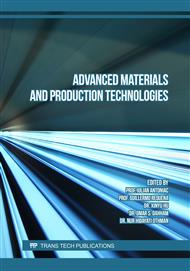p.129
p.135
p.147
p.157
p.171
p.179
p.187
p.193
p.199
Experimental Study on Improving Frost Resistance of Ca Mortar
Abstract:
Cement asphalt mortar (CA mortar) is one of the key materials of slab ballastless track structure, and its performance directly affects the overall quality of ballastless track. The design of CA mortar mix proportion is studied by orthogonal exerimental method, and the reasonable dosage of cement, emulsified asphalt, sand and other materials is determined. The change of gas content of CA mortar is analyzed by adding air entraining agent and adjusting stirring process. The working properties, mechanical properties and freezing resistance of CA mortar are tested. The results show that the reasonable dosage of cement, emulsified asphalt and sand in CA mortar are 280~325kg/m3, 420~555kg/m3 and 360~690kg/m3, respectively. The dosage of cement has the most obvious influence on the 28d compressive strength of CA mortar, followed by emulsified asphalt. With the increase of air entraining agent content, stirring speed and stirring time, the air content in mortar will increase. Through the test of mortar's working performance, mechanical properties and frost resistance, it is shown that the appropriate amount of air entraining agent and mixing process can improve the frost resistance of CA mortar.
Info:
Periodical:
Pages:
193-198
Citation:
Online since:
December 2022
Authors:
Price:
Сopyright:
© 2022 Trans Tech Publications Ltd. All Rights Reserved
Share:
Citation:



